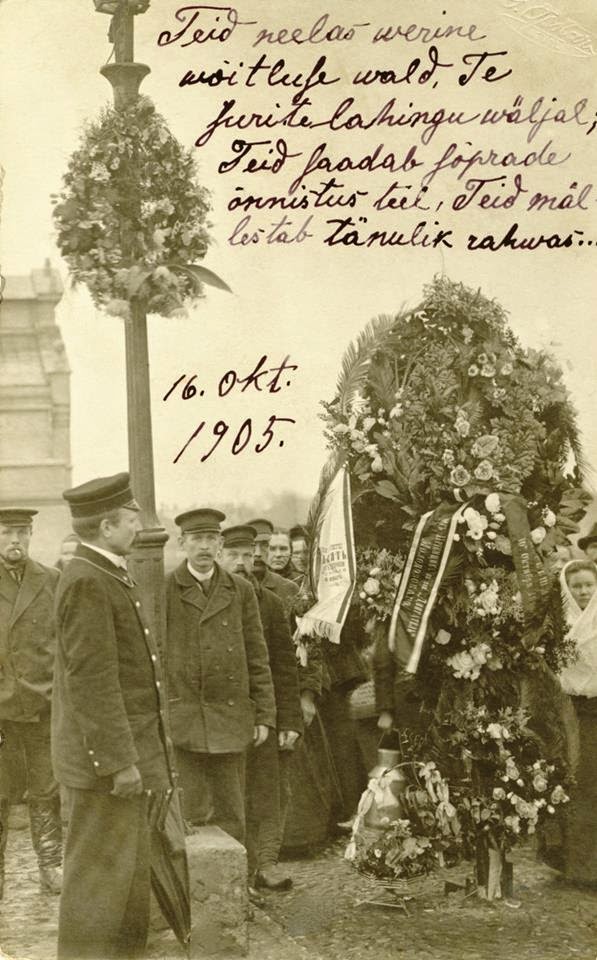On 16th October 1905 a horrific event took place in the centre of Tallinn. During a peaceful demonstration held at the New Market, Tallinn's inhabitants gathered to call for civil rights and to protest against Russian autocracy. Under the orders of Governor Lopukhin, General Voronov and Captain Mironov, the Russian Army opened fire upon civilians, killing 94 people and wounding over 200. It was a bloodbath seeing partially decapitated bodied strewn across the marketplace and some bullets reaching a distance of 2 km away.
The history leading up to the event.
After Russia's defeat in the Russo-Japanese War (8th February 1904 - 5th September 1905) the Tsar had lost both strength and prestige. After this weakness was exposed a revolution broke out in Russia which set off a series of strikes and political meetings taking place in factories and educational institutions. These revolutionary activities also proliferated in Estonia, giving rise to the Estonian national awakening. Both socialists and nationalists in Estonia wanted to limits the rights of Baltic Germans and put an end to Russification. Those passionate about the cause of ending German hegemony often took matters into their own hands and burned down manor houses all over Estonia. Harju county was the hardest hit with 70 manor houses set ablaze. Official records state that 114 manors in North Estonia and 230 manors in Livonia were affected by arson, looting and destruction during this time.
New Market in Tallinn was located where Tammsaare Park and the Estonian Theatre stands today.
It was not only the military who were firing upon civilians at marketplace that day but also aristocrats, the sons of manor owners who wanted revenge for all the burnings and vandalism inflicted upon their estates. My great, great grandfather Alexander Otto Lesthal, a former manor steward and Pirita tavern owner who was also the representative for St.Petersburg Kalinkin beer in Tallinn was a witness to the 1905 massacre. His colleague, Aleksander Rannamets later included his account in a memoir that was published in Vaba Maa (Free Country) newspaper in 1935.
Alexander Lesthal's eye witness account:
On the day of the bloodbath, Alexander saw several young aristocrats going into a large stone building in the same vicinity, opposite the marketplace. Guns were strewn across their flabby bellies. Alexander then pushed open his living room window and placed the tube of a sound amplifying device to his ear in order to gain a better understanding of what was happening around him. Gunshots were ringing out everywhere and he then saw the smoke of gunpowder exiting one of the windows from the stone building's third floor. Afterwards people gathered around a podium and shouts sounded out "Dead, dead! ..... Look he's still alive" etc. Alexander's heart could not take it but he feared to get any closer in case they fired fort a second time. He acknowledged that he knew quite a few of those young barons involved.
The horrific event took place on 16 October 1905 (old calendar) 29 October (new calendar). In Estonia the calendar changed from the Julian calendar to the Gregorian calendar on 14.2.1918.
The original 1905 wooden monument located where the Estonia Theatre stands today.
The funeral procession that took place on 20 October 1905.
It was attended by over 4000 people.
Final resting place. Rahumäe Cemetery, Tallinn.
In 1935 the Vaba Maa newspaper published the 1905 memoir of elderly Harju County tavernkeeper Aleksander Rannamets. The five page series, nr.243-247, October 15-19, 1935 described the political upheaval in 1905 including his conversation with Alexander Otto Lesthal relating to all the manor burnings that were taking place at the time. Aleksander Rannamets owned the Niida tavern in Jöelahtme parish, Harju county.
Honouring the victims of the 1905 massacre is this granite monument at Rahumäe Cemetary. Created by sculptor Juhan Raudsepp, it symbolises the wheel of history.
.jpg)






